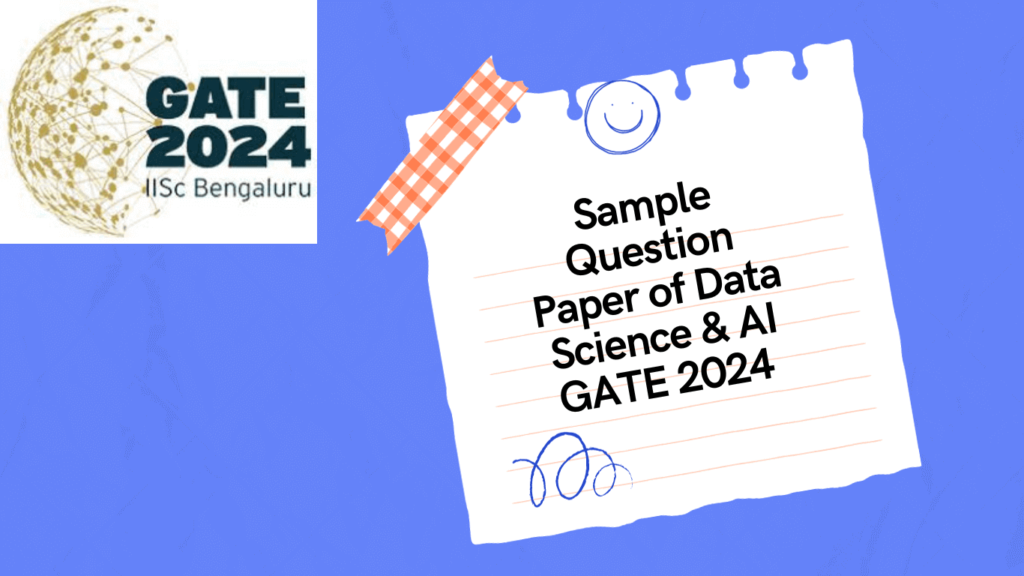Hey Guys Welcome to CSE Stud 247 , Today I am provide you Sample Question Paper of Data Science & AI GATE 2024 that is very useful for upcoming GATE Exam 2024 for Data Science and AI Students.
Data Science is a multidisciplinary field that combines techniques from statistics, computer science, and domain knowledge to extract insights and knowledge from data. It involves the collection, cleaning, analysis, and interpretation of data to solve complex problems and make data-driven decisions. Data scientists use a variety of tools and techniques to uncover patterns, trends, and meaningful information from data.

Artificial Intelligence (AI) refers to the simulation of human intelligence in machines that are programmed to think, learn, and problem-solve like humans. AI systems can perform tasks that typically require human intelligence, such as understanding natural language, recognizing patterns, making decisions, and adapting to changing circumstances. AI technologies are at the forefront of technological advancements and have a wide range of applications across various industries
Table of Contents
GATE Data Science and Artificial Intelligence Syllabus 2024
Below the given syllabus in the written format and PDF Format
- Probability and Statistics
- Linear Algebra
- Calculus and Optimization
- Programming, Data Structures, and Algorithms
- Database Management and Warehousing
- Machine Learning
- AI (Artificial Intelligence)
| Subject | Details |
|---|---|
| Linear Algebra | Vector space, subspaces, linear dependence and independence of vectors, matrices, projection matrix, orthogonal matrix, idempotent matrix, partition matrix and their properties, quadratic forms, systems of linear equations and solutions; Gaussian elimination, eigenvalues and eigenvectors, determinant, rank, nullity, projections, LU decomposition, singular value decomposition. |
| Probability and Statistics | Counting (permutation and combinations), probability axioms, Sample space, events, independent events, mutually exclusive events, marginal, conditional and joint probability, Bayes Theorem, conditional expectation and variance, mean, median, mode and standard deviation, correlation, and covariance, random variables, discrete random variables and probability mass functions, uniform, Bernoulli, binomial distribution, Continuous random variables and probability distribution function, uniform, exponential, Poisson, normal, standard normal, t-distribution, chi-squared distributions, cumulative distribution function, Conditional PDF, Central limit theorem, confidence interval, z-test, t-test, chi-squared test. |
| Calculus and Optimization | Functions of a single variable, limit, continuity and differentiability, Taylor series, maxima and minima, optimisation involving a single variable. |
| Programming, Data Structures and Algorithms | Programming in Python, basic data structures: stacks, queues, linked lists, trees, hash tables; Search algorithms: linear search and binary search, basic sorting algorithms: selection sort, bubble sort and insertion sort; divide and conquer: merge sort, quicksort; introduction to graph theory; basic graph algorithms: traversals and shortest path. |
| Database Management and Warehousing | Database Management and WarehousingER-model, relational model: relational algebra, tuple calculus, SQL, integrity constraints, normal form, file organisation, indexing, data types, data transformation such as normalisation, discretisation, sampling, compression; data warehouse modelling: schema for multidimensional data models, concept hierarchies, measures: categorisation and computations. |
| Machine Learning | (i) Supervised Learning: regression and classificaƟon problems, simple linear regression, mulƟple linear regression, ridge regression, logisƟc regression, k-nearest neighbour, naive Bayes classifier, linear discriminant analysis, support vector machine, decision trees, bias variance trade-off, cross-validaƟon methods such as leave-one-out (LOO) cross-validaƟon, k-folds crossvalidaƟon, mulƟ-layer perceptron, feed-forward neural network; (ii) Unsupervised Learning: clustering algorithms, k-means/k-medoid, hierarchical clustering, top-down, boƩom-up: single-linkage, mulƟplelinkage, dimensionality reducƟon, principal component analysis. |
| AI | Search: informed, uninformed, adversarial; logic, propositional, predicate; reasoning under uncertainty topics – conditional independence representation, exact inference through variable elimination, and approximate inference through sampling |
GATE 2024 DA & AI Exam Pattern
| Paper Name | GATE Data Science and Artificial Intelligence Paper |
| Paper Code | DA |
| Type of Questions | MCQs, MSQs, and NATS |
| Section | General Aptitude + Data Science and AI |
| GATE DA Paper Marks Distribution | General Aptitude: 15 Marks Data Science and AI Subject Questions: 85 Mark |
| Negative Marking | For a 1-mark MCQ, an incorrect answer will result in a deduction of 1/3 mark. For a 2-mark MCQ, an incorrect answer will lead to a deduction of 2/3 marks. There is no penalty for incorrect responses to MSQ or NAT questions. |
Download Sample Question Paper of Data Science & AI GATE 2024
Join For More Update
| Official Telegram | Click Here |
| GATE 2023 Question Paper With Solution of CSE/IT | Click Here |
| You Tube | Click Here |
| Download CSE/IT GATE Syllabus | Click Here |